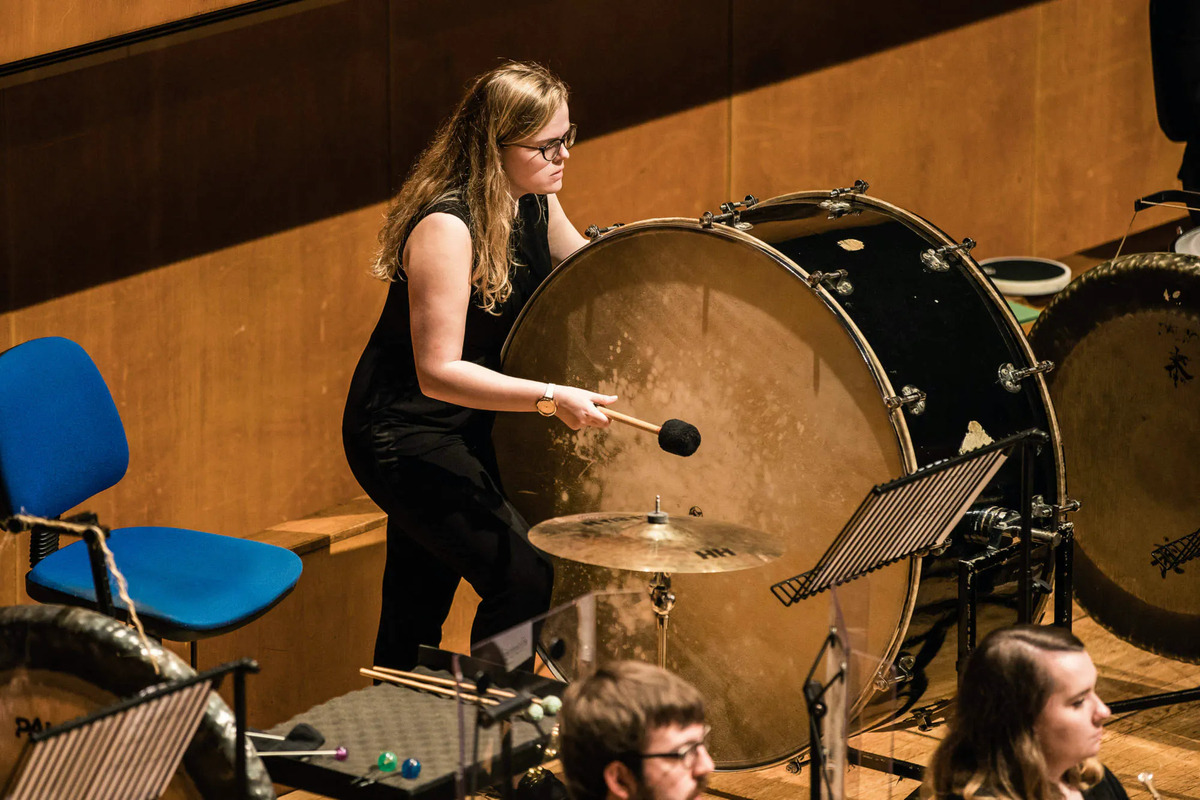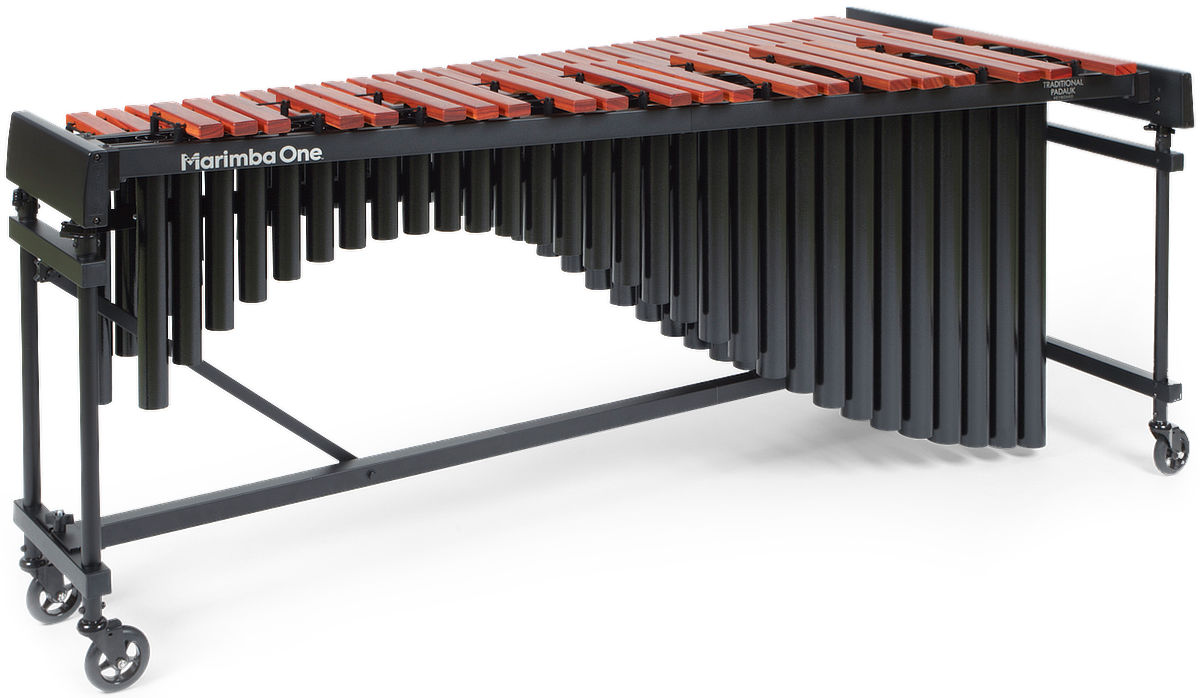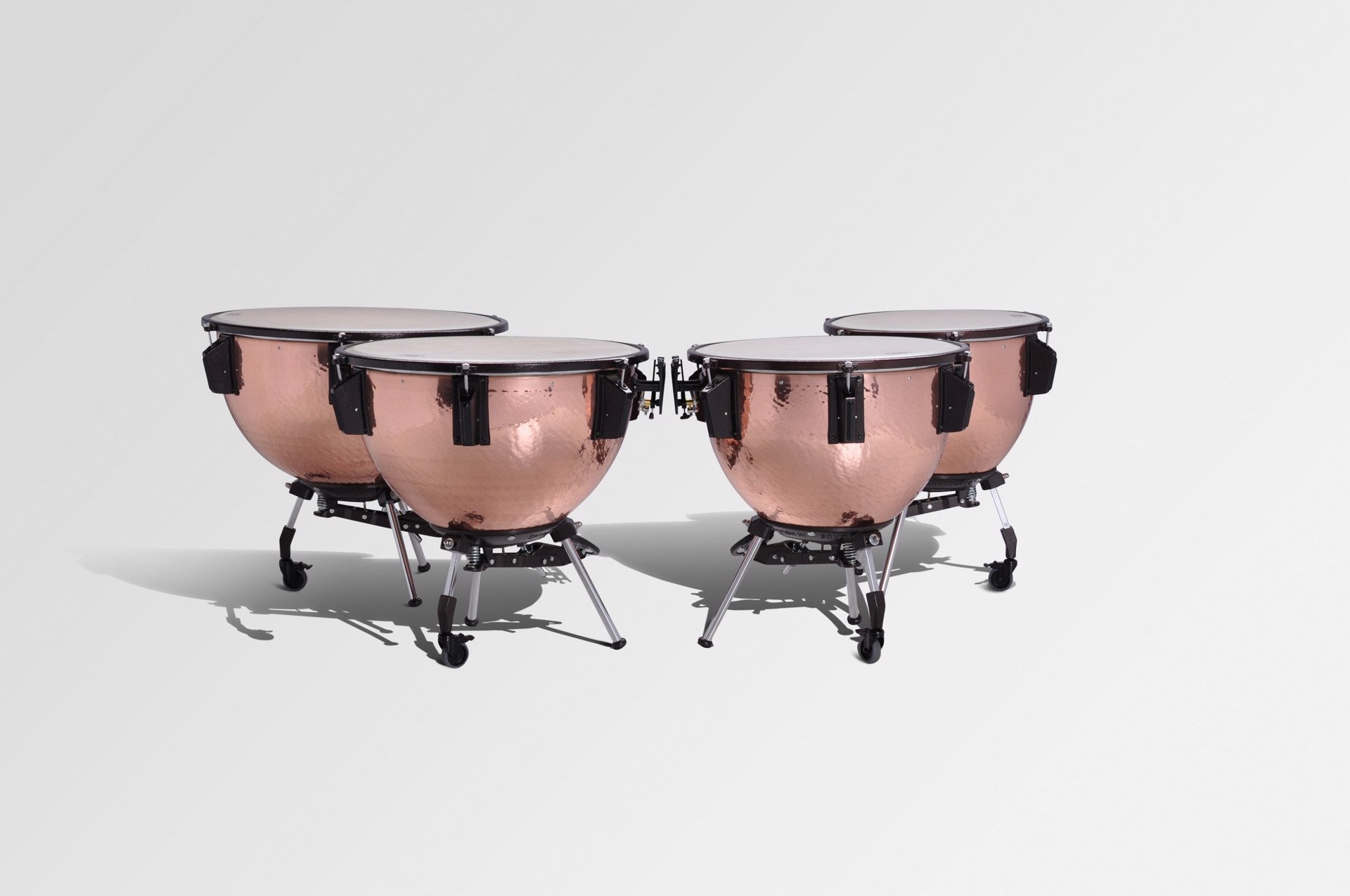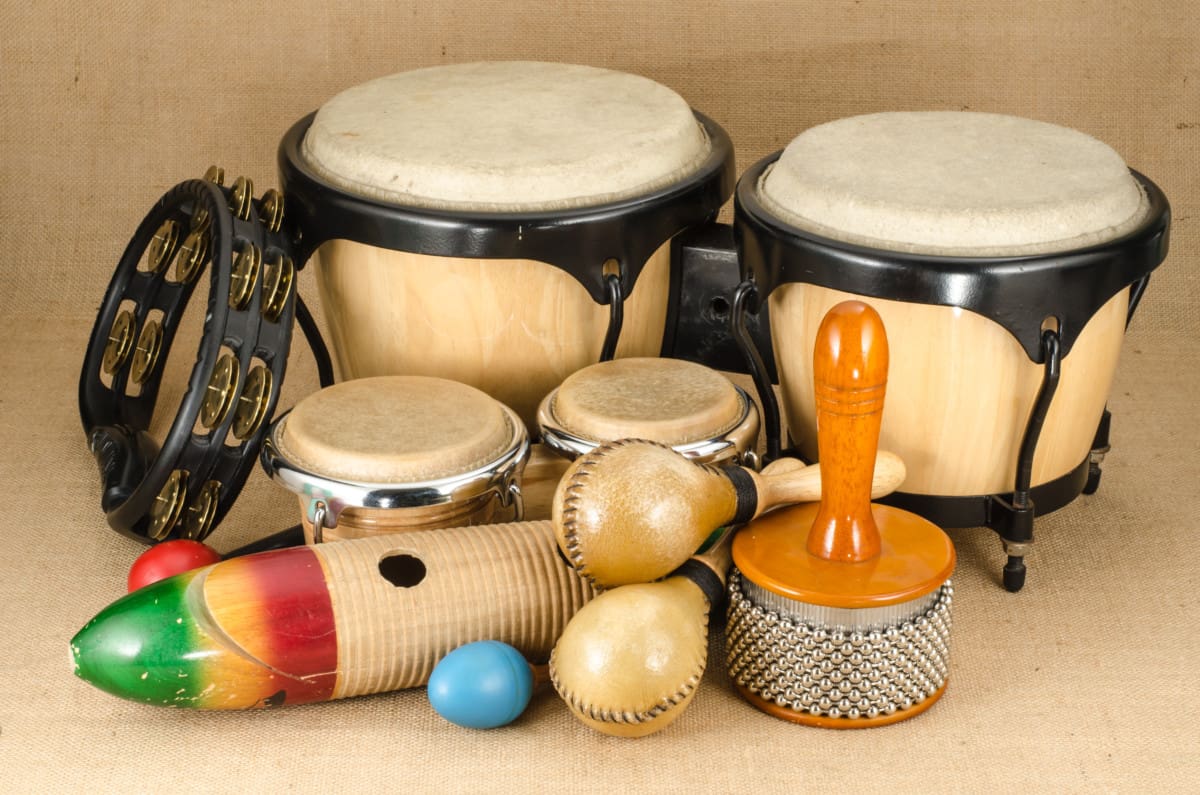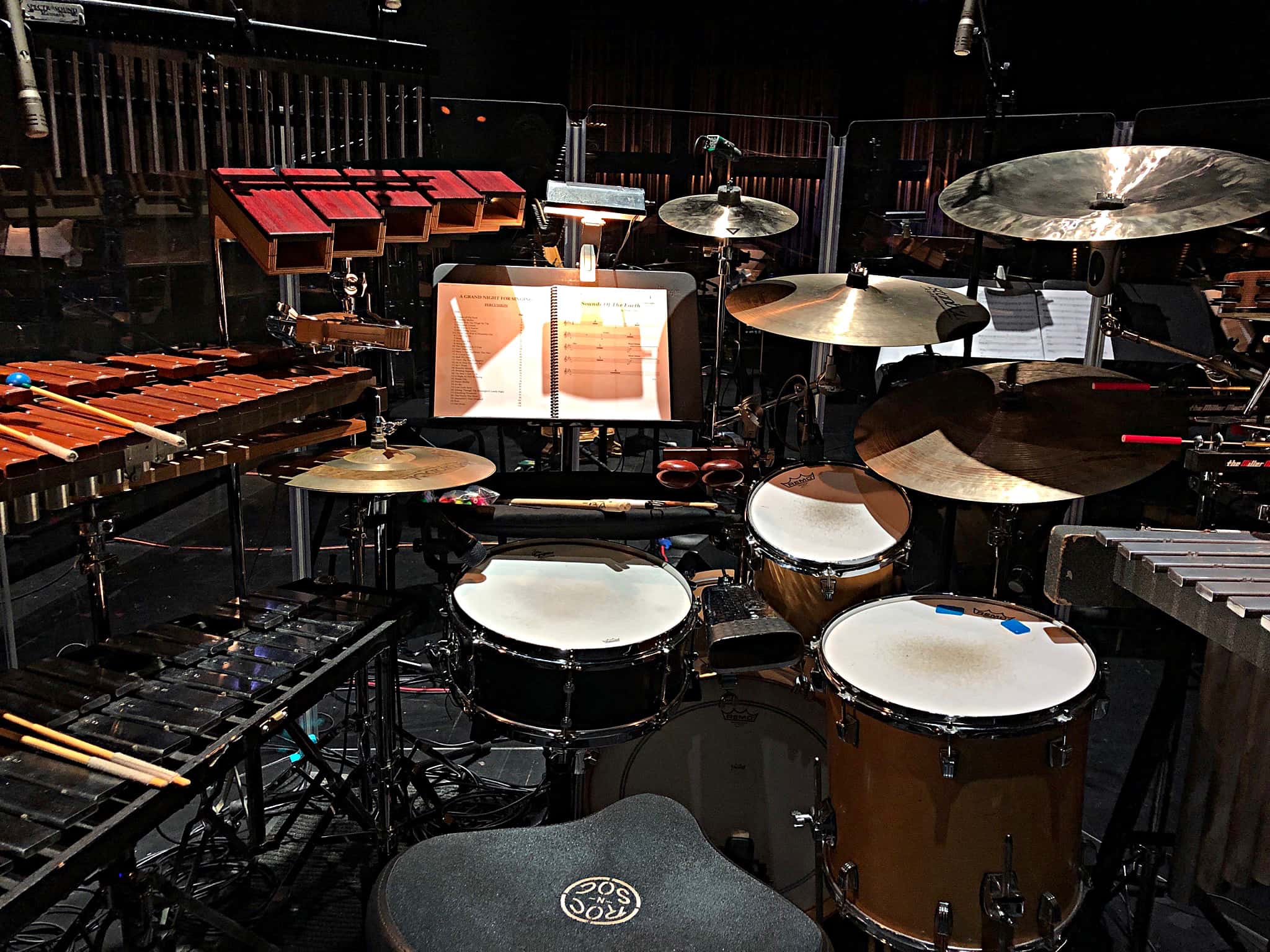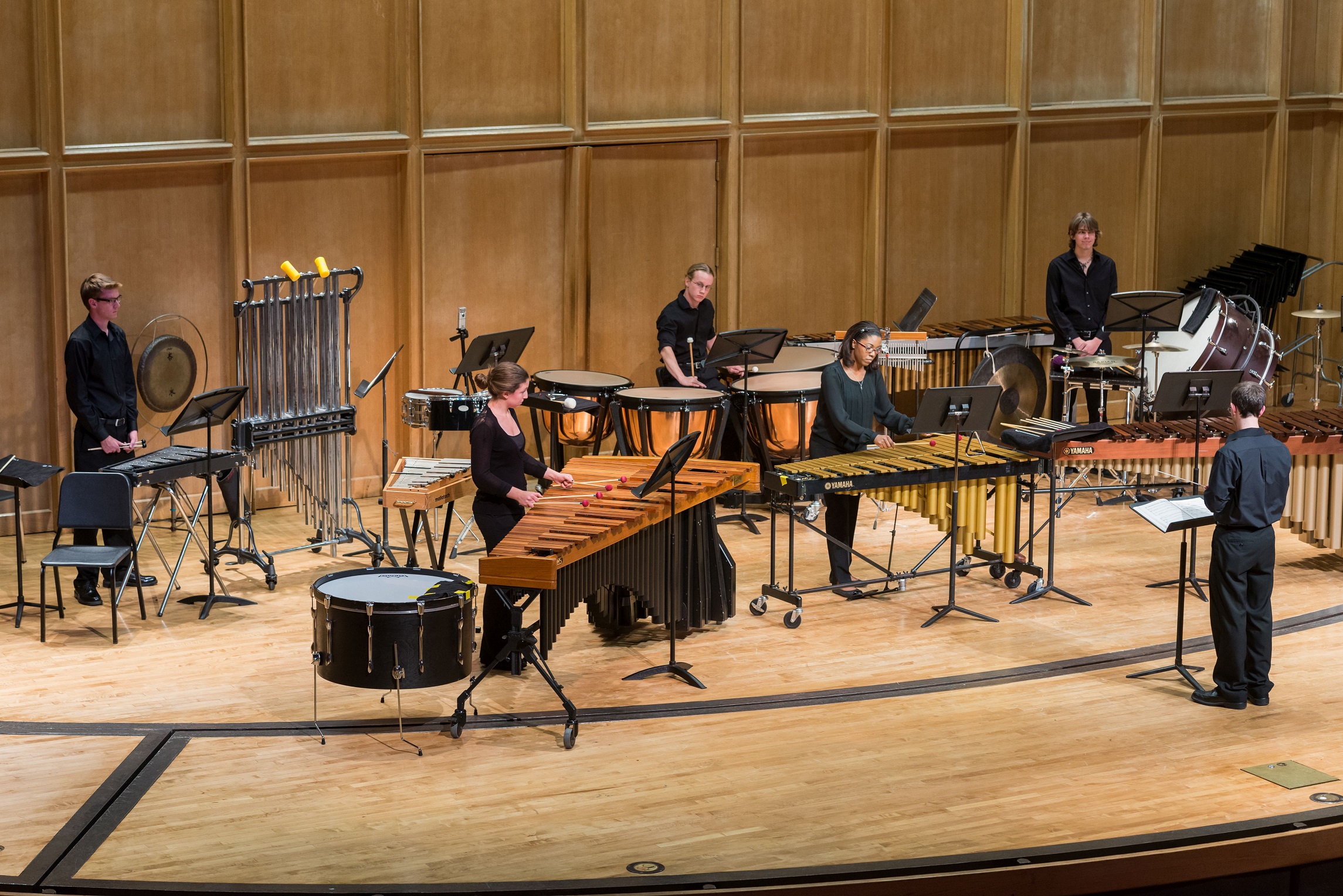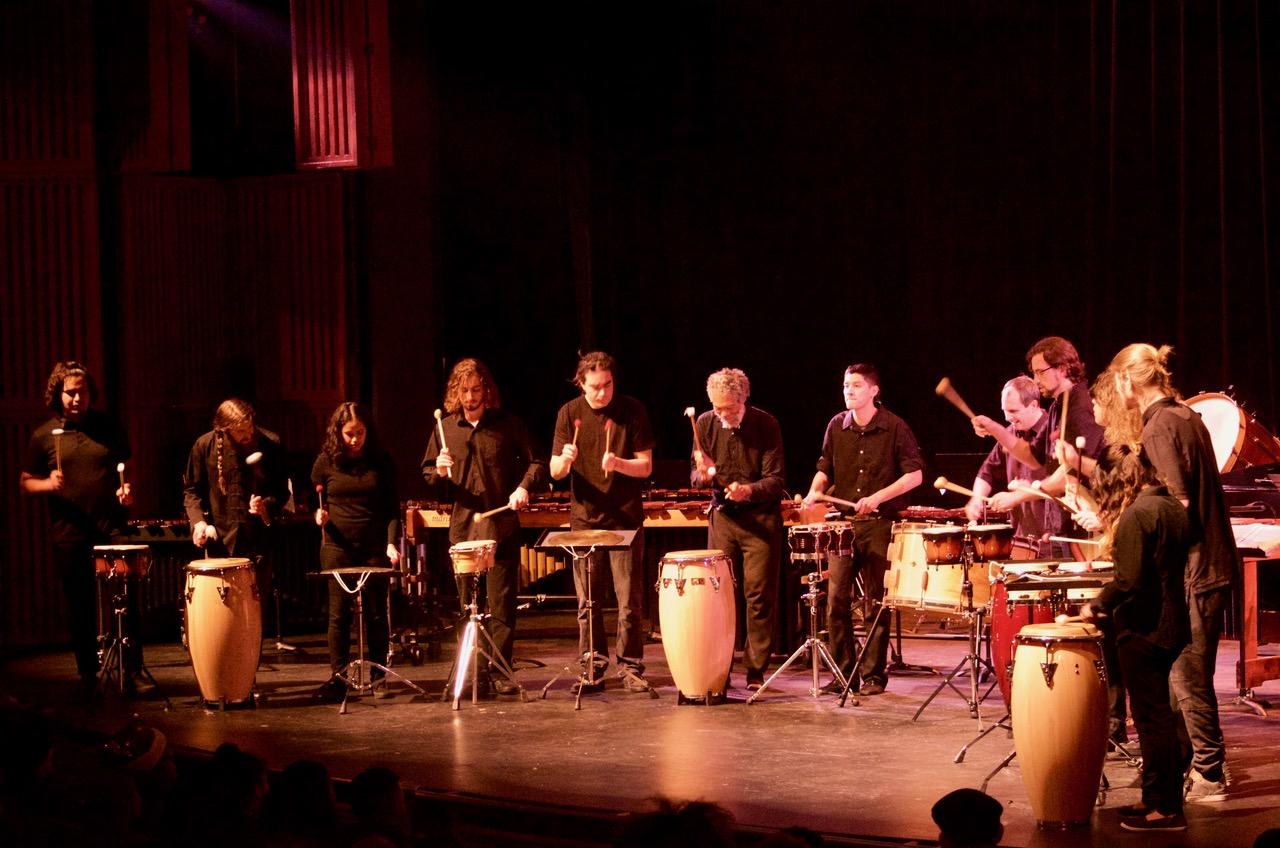Home>Instruments>Percussion Instruments>Which Percussion Instruments Are Untuned


Percussion Instruments
Which Percussion Instruments Are Untuned
Modified: February 18, 2024
Discover the fascinating world of untuned percussion instruments. From drums to shakers, explore the rich diversity of percussion instruments and their unique sounds.
(Many of the links in this article redirect to a specific reviewed product. Your purchase of these products through affiliate links helps to generate commission for AudioLover.com, at no extra cost. Learn more)
Table of Contents
Introduction
Percussion instruments are an essential part of musical ensembles, adding rhythm, texture, and depth to a piece of music. These instruments are versatile, existing in various forms and sizes, and are used in different genres and cultures around the world. Percussion instruments can be broadly categorized into two types: tuned and untuned.
In this article, we will focus on untuned percussion instruments. Unlike tuned percussion instruments such as xylophones or marimbas, untuned percussion instruments do not produce specific pitches or notes. Instead, their primary function is to provide rhythm and texture to the music. These instruments are often used to create interesting and catchy beats that complement the melody and harmonies played by other instruments.
Untuned percussion instruments come in a wide range of shapes, sizes, and materials, each producing a unique sound. In this article, we will explore some of the most commonly used untuned percussion instruments, their characteristics, and the roles they play in musical compositions.
Whether you are an aspiring musician, a curious music lover, or simply want to expand your knowledge of percussion instruments, this article will provide you with insights into the fascinating world of untuned percussion instruments.
Definition of Percussion Instruments
Percussion instruments are a diverse family of musical instruments that produce sound by being struck, shaken, or scraped. They are known for their distinctive rhythmic and textural qualities, and they play a vital role in various musical genres and cultures worldwide.
What sets percussion instruments apart from other types of instruments is their ability to produce sound without the need to generate specific pitches or notes. Instead, they create percussive sounds that add rhythm and groove to musical compositions. Whether it’s the exhilarating beat of a drum, the shimmering resonance of cymbals, or the rhythmic jingle of tambourines, percussion instruments contribute to the overall energy and flavor of a musical piece.
Percussion instruments can be further categorized into two main types: tuned and untuned. Tuned percussion instruments, such as xylophones or marimbas, are capable of producing specific pitches and melodies. On the other hand, untuned percussion instruments, which we will focus on in this article, produce sounds that are not tied to specific pitches or notes.
While tuned percussion instruments are often used to play melodies and harmonies, untuned percussion instruments primarily serve the purpose of creating rhythmic patterns and textures. They can be found in various musical genres, including classical music, jazz, rock, pop, world music, and more.
As we delve into the topic of untuned percussion instruments, it’s important to note that the distinction between tuned and untuned percussion is not always black and white. Some percussion instruments, such as the piano, can fall into both categories depending on how they are played. However, for the purpose of this article, we will focus specifically on untuned percussion instruments and explore their diverse characteristics and roles in music.
Classifying Percussion Instruments
Percussion instruments can be classified in various ways, based on their playing technique, sound production mechanism, or cultural origins. One common classification system divides percussion instruments into two main categories: tuned and untuned.
Tuned percussion instruments, as the name suggests, are capable of producing specific pitches and melodies. Examples of tuned percussion instruments include the xylophone, marimba, vibraphone, and tubular bells. These instruments have specific notes assigned to each of their individual bars or tubes, allowing musicians to play melodies and harmonies.
On the other hand, untuned percussion instruments are characterized by their ability to produce percussive sounds without specific pitches or notes. These instruments often provide a rhythmic foundation and add texture to music. They are essential for creating dynamic beats, accents, and fills.
Untuned percussion instruments can be further categorized based on their physical characteristics and the way they are played. Some examples include drums, tambourines, cymbals, triangles, shakers, maracas, cowbells, woodblocks, rainsticks, and guiros.
Drums are one of the most widely recognized and essential untuned percussion instruments. They come in various sizes and shapes, including bass drums, snare drums, and tom-toms. Drums are played by striking or using hands, sticks, or mallets to produce rhythmic patterns and beats.
Tambourines are another popular untuned percussion instrument. They consist of a circular frame with a series of metal jingles around the edge. They are played by shaking or striking the instrument, creating a jingling and vibrant sound that adds excitement and energy to music.
Cymbals are metallic untuned percussion instruments commonly found in many musical genres. They are made of thin circular plates of metal and are played by striking or clashing them together. They produce a crashing and sustained sound that can create dramatic accents and fills in music.
The triangle is a small, metal instrument shaped like a triangle. It is played by striking it with a metal beater, resulting in a clear and ringing sound. The triangle adds shimmer and sparkle to musical compositions and is often used in orchestral and chamber music.
Shakers, like maracas, cowbells, woodblocks, rainsticks, and guiros, are handheld instruments that produce sound by shaking, striking, or scraping. Each of these instruments has its own unique sound and texture, contributing to the overall rhythmic and percussive elements in a musical piece.
Understanding the classification of untuned percussion instruments allows musicians and enthusiasts to appreciate the diverse range of sounds they can produce. Incorporating these instruments into compositions can add depth, rhythm, and excitement, enriching the musical experience for both performers and listeners.
Category 1: Untuned Percussion Instruments
Untuned percussion instruments encompass a variety of instruments that do not produce specific pitches or notes. They are indispensable in creating rhythmic patterns, adding texture, and providing a solid foundation to musical compositions. In this section, we will explore ten common untuned percussion instruments and their unique characteristics.
- Drum Set: The drum set, also known as a drum kit, is a versatile and fundamental untuned percussion instrument. It comprises various drums such as the bass drum, snare drum, tom-toms, and cymbals. The drummer uses drumsticks, brushes, or mallets to strike the different components, creating a rhythmic pulse and driving force in a band or ensemble.
- Tambourine: The tambourine is a handheld instrument that consists of a circular frame with metal jingles or small cymbals attached to it. It is played by shaking, striking, or tapping the instrument. The tambourine’s jingling sound adds a lively and percussive element to many styles of music, from folk to pop to jazz.
- Cymbals: Cymbals are large, metallic, and circular plates that produce a crashing sound when struck together or individually. They come in various sizes and are often used to create dramatic accents and crescendos in orchestral and rock music. The clash of cymbals adds a powerful and resonant quality to musical compositions.
- Triangle: The triangle is a small metal instrument shaped like a triangle. It is suspended by a string and played by striking it with a metal beater. The triangle’s clear and ringing tone is often used to add a delicate and shimmering sound to orchestral and chamber music.
- Shakers: Shakers, such as maracas, are handheld instruments that produce sound when shaken. Maracas consist of hollow gourds or balls filled with beads or seeds, while other shakers can be made of materials like plastic or metals. Shakers add a percussive and rhythmic element to various genres, including Latin American, Caribbean, and world music.
- Maracas: Maracas are traditional Latin American percussion instruments consisting of two hollow gourd or wooden shells filled with beads or seeds. When shaken, they create a distinctive rattling sound. Maracas are widely used in Latin music, adding rhythmic complexity and texture to the groove.
- Cowbell: The cowbell is a metal percussion instrument with a deep, resonant sound. It is typically played by striking it with a drumstick or mallet. Cowbells are commonly used in various music genres, including rock, salsa, and marching bands, to create a driving and upbeat rhythm.
- Woodblock: The woodblock is a wooden instrument that produces a distinct and resonant sound when struck with a stick or mallet. It is commonly used in orchestral music and adds a percussive and rhythmic element, often representing the distinctive sound of nature in certain compositions.
- Rainstick: The rainstick is a long, hollow tube filled with small pebbles or beans. When tilted and turned, the pebbles fall through a series of baffles, creating a sound reminiscent of rainfall. Rainsticks are often used in world and ambient music to create a calming and atmospheric effect.
- Guiro: The guiro is a Latin American percussion instrument made of wood or metal. It has ridges or grooves along its body and is played by scraping a stick or a scraper across the ridges. The guiro adds a distinctive rhythmic texture and a vibrant percussive sound to various styles of music, including salsa and tropical genres.
These untuned percussion instruments each have their unique characteristics and are essential in creating rhythm, texture, and energy in music. From the thunderous beats of the drum set to the intricate patterns of the guiro, these instruments bring vitality and depth to musical compositions across a wide range of genres.
#1. Drum Set
The drum set, also known as a drum kit, is a versatile and essential untuned percussion instrument found in various musical genres. It consists of a collection of drums, cymbals, and other percussion instruments that are played simultaneously by a drummer.
The main components of a drum set include:
- Bass Drum: This large, floor-mounted drum produces a deep and low-frequency sound. It is played by using a foot pedal to strike a mallet against the drumhead.
- Snare Drum: The snare drum is one of the focal points of the drum set. It has a distinctive snappy sound due to the snare wires stretched across the bottom drumhead. The snare drum is hit with drumsticks, creating a sharp attack and vibrant tone.
- Tom-Toms: Tom-toms are drums of various sizes and pitches that are mounted on the drum set. They are played with drumsticks and are responsible for adding depth, texture, and fills to the rhythm section of a song.
- Cymbals: Cymbals are an integral part of the drum set and come in different types, including ride cymbals, crash cymbals, and hi-hats. Ride cymbals are large and produce a sustained sound when struck with a drumstick or mallet. Crash cymbals, as the name suggests, create a loud and explosive sound when clashed together. Hi-hats consist of two cymbals mounted on a stand and are played with drumsticks or with the foot pedal to create a distinctive “chick” sound.
- Pedals: Drum pedals are used to operate various components of the drum set, such as the bass drum and hi-hat cymbals. The bass drum pedal is used to strike the bass drum, while the hi-hat pedal controls the opening and closing of the hi-hat cymbals.
The drum set is a versatile instrument that provides the foundation and driving force of a band or ensemble. The drummer uses a combination of sticks, brushes, or mallets to create a wide range of sounds and rhythms. They play different parts of the drum set simultaneously, coordinating their hands and feet to maintain a steady beat and add dynamic fills.
The drum set is prevalent in various genres, including rock, pop, jazz, funk, and many more. It sets the tempo, establishes the groove, and interacts with other instruments to create a cohesive and cohesive musical experience. Whether providing a thunderous backbeat, intricate rhythms, or explosive fills, the drum set is a key contributor to the overall energy and drive of a musical performance.
#2. Tambourine
The tambourine is a handheld untuned percussion instrument that adds a distinctive jingling sound to music. It consists of a circular frame made of wood or plastic, with small metal jingles, known as zils, attached to the edges. The tambourine can be played by shaking, striking, or tapping the instrument.
The jingles or zils produce a bright and shimmering sound when the tambourine is shaken, creating a percussive layer that adds energy and texture to a musical composition. As the tambourine is struck or tapped, it produces a crisp percussive attack that can cut through the sound of other instruments, making it an effective accenting tool.
The tambourine is commonly associated with folk, rock, pop, and world music, and it is used in various cultural traditions across the globe. In folk music, the tambourine is often played in a rhythmic manner, providing a driving force and enhancing the overall groove.
In rock and pop music, the tambourine is used to add color and excitement to songs. It is frequently employed in chorus sections or during climactic moments to create a sense of energy and climactic impact. Many iconic songs feature the tambourine prominently, such as “Gimme Shelter” by The Rolling Stones and “Here Comes the Sun” by The Beatles.
Aside from shaking and striking, the tambourine can also be employed in a technique called the “thumb roll.” This technique involves rolling the thumb along the edge of the tambourine’s head while holding the frame. This produces a sustained and rolling sound, adding a different rhythmic element to the instrument’s repertoire.
The tambourine is a versatile and accessible instrument that can be played by musicians of all skill levels. Its distinctive sound and rhythmic capabilities make it a popular choice for live performances and studio recordings, adding a vibrant and percussive layer to any musical arrangement.
Whether lending a festive atmosphere to a folk song, providing a rhythmic pulse in a rock anthem, or adding a touch of sparkle in a pop ballad, the tambourine remains a beloved and essential untuned percussion instrument in the world of music.
#3. Cymbals
Cymbals are an essential part of the untuned percussion family, known for their distinctive and powerful sound. They are metallic instruments that consist of round, flat plates made of various alloys, typically bronze or brass. Cymbals produce their characteristic sound when they are struck together or individually.
There are different types of cymbals, each with its unique qualities:
- Ride Cymbals: Ride cymbals are usually the largest cymbals in a drum set. They have a pronounced and sustained sound that gives them their name; they provide a ride-like quality to the music. Drummers commonly play them with a drumstick or mallet, creating patterns, accents, and crashing sounds.
- Crash Cymbals: Crash cymbals are smaller than ride cymbals and produce a bright and explosive sound. They create a bold and dramatic impact in a musical composition when clashed together. Crash cymbals are often used to accentuate specific moments or transitions in a piece of music.
- Hi-Hat Cymbals: Hi-hat cymbals consist of two cymbals mounted on a stand, forming a pair of cymbals that can be opened and closed with a foot pedal. When closed, they produce a crisp “chick” sound, and when opened, they create a sustained sound. Hi-hat cymbals are played with drumsticks or through the foot pedal, adding intricate rhythms and dynamic accents to music.
Cymbals are known for their versatility and are used in a wide range of musical genres, including rock, jazz, orchestral, and more. In rock music, cymbals often provide crashing accents and fills to create an intense and energetic atmosphere. In jazz, cymbals are used to establish a groove, add texture, and create complex rhythmic patterns.
The technique of playing cymbals involves striking them with drumsticks, mallets, or brushes, as well as using different parts of the cymbals to achieve a range of sounds. Drummers vary their strikes, from light taps to forceful crashes, to bring out different tonal characteristics and dynamics.
From shimmering ride patterns to explosive crash accents, cymbals add depth, color, and excitement to music. Their powerful and vibrant sounds make them prominent in live performances and studio recordings, helping to elevate the overall impact and intensity of a musical piece.
Whether providing a driving force, creating dramatic accents, or adding intricate rhythms, cymbals play a crucial role in shaping the sonic landscape and enhancing the rhythmic dynamics of untuned percussion instruments.
#4. Triangle
The triangle is a small, but significant, untuned percussion instrument, known for its clear and distinctive sound. It is shaped like a triangle, hence its name, and is made of steel or other metal alloys. The triangle produces a ringing and resonant sound when struck with a metal beater or striker.
In an orchestra or ensemble, the triangle serves as a vital component of the percussion section. It adds a touch of sparkle, accents, and color to the overall orchestration. Despite its simple structure, the triangle’s sound has the ability to cut through the texture of other instruments, thus allowing it to be heard clearly.
Playing the triangle involves holding the instrument with one hand while striking it with the beater held in the other hand. The position, angle, and point of contact on the triangle all influence the sound produced. Its unique sound is characterized by a strong attack followed by a sustained and shimmering tone.
The triangle is used in a wide range of musical genres, including classical, jazz, pop, and more. In orchestral compositions, it is often utilized to add delicate accents, create ethereal atmospheres, or highlight specific moments in the music. The sound of the triangle can evoke various emotions, from mystery to excitement, depending on how it is played and integrated into the composition.
The triangle’s versatility extends beyond orchestral settings. It has also found its way into popular music genres, where it is often used to add a whimsical or playful element to a song. Well-known songs featuring the triangle include “Money” by Pink Floyd and “The Lion Sleeps Tonight” by The Tokens.
When played skillfully, the triangle can be a captivating and integral part of a musical performance. Its simple yet distinct sound contributes to the overall sonic tapestry, adding a touch of charm and brilliance to any piece of music.
Despite its unassuming appearance, the triangle’s bright and resonating tones continue to make it a valued and celebrated instrument in the world of untuned percussion.
#5. Shakers
Shakers are handheld untuned percussion instruments that produce sound through shaking or striking. They consist of a container or body filled with various materials, such as beans, seeds, or small pellets, which create a rattling or shaking sound when the instrument is moved.
Shakers come in a variety of shapes and sizes, with different materials used for the body. They can be made of wood, plastic, gourds, or even metal. The body is designed to allow for easy gripping and shaking, creating rhythmic patterns and textures.
When the shaker is shaken, the materials inside bounce off the walls, producing a percussive sound. The intensity and speed of the shaking will influence the volume and rhythmic complexity of the sound produced. Some shakers have a rough surface or ridges, enhancing the rattling effect and adding a distinct texture to the sound.
Shakers are found in various musical genres, including Latin American, Caribbean, African, and world music. They are often used to provide a subtle rhythmic foundation or as an embellishment to enhance the groove of a composition.
Maracas are a well-known type of shaker, consisting of hollow gourds or balls filled with beads or seeds. When shaken, maracas produce a characteristic rattling sound that is synonymous with Latin music. These instruments are often used to add syncopated rhythms and lively accents to salsa, merengue, and other Latin American genres.
Other types of shakers include egg shakers, made of plastic or wood and filled with small pellets, and rainmakers, which simulate the sound of falling rain through the controlled movement of beads or small stones. Each type of shaker offers unique sounds and textures, enabling musicians to create a wide array of rhythmic patterns and effects.
Shakers are versatile and accessible instruments that can be played by individuals of all musical abilities. They are often included in classroom settings, therapeutic music sessions, and community drum circles, allowing people to contribute to musical experiences without requiring extensive training.
Whether adding a subtle pulse, creating intricate rhythms, or contributing to a vibrant and lively atmosphere, shakers bring a distinctive and rhythmic element to untuned percussion ensembles and musical compositions.
#6. Maracas
Maracas are well-known untuned percussion instruments commonly associated with Latin American music. They consist of a pair of hollow gourds or balls, filled with beads, seeds, or small stones. When shaken, maracas produce a characteristic rattling sound that adds a lively and rhythmic element to music.
The distinctive sound of maracas comes from the materials placed inside the gourd. As the maracas are shaken, the beads or seeds collide with the walls of the gourd, creating a rhythmic percussion effect. The size and type of materials used will influence the timbre and intensity of the sound produced.
Maracas have a long history and are deeply rooted in Latin American and Caribbean cultures. They are widely used in genres such as salsa, merengue, cumbia, and other traditional music styles. In these genres, maracas play a crucial role in providing syncopated rhythms, accentuating clave patterns, and adding a vibrant and celebratory flavor to the music.
Playing the maracas involves holding one in each hand and shaking them in a rhythmic and controlled manner. The speed, intensity, and pattern of the shakes can vary depending on the desired rhythmic effect. Skilled percussionists can produce intricate and complex rhythms by combining different shake patterns and accents.
In addition to Latin American music, maracas have gained popularity in various other genres, including pop, rock, and world music. They provide a distinct percussive texture and a tropical vibe to songs, making them a versatile and appealing instrument in different musical contexts.
Maracas are not only instruments for professional musicians but are also employed in educational settings and recreational music-making. They are accessible to players of all skill levels and ages, making them suitable for classrooms, drum circles, and community music events.
Whether in a lively salsa performance, a tropical pop song, or a festive gathering, the maracas’ vibrant sound and rhythmic characteristics have the power to uplift spirits, engage listeners, and ignite a sense of joy and celebration.
#7. Cowbell
The cowbell is a percussive instrument that belongs to the untuned percussion family. It is a hollow metal bell with a distinctive shape resembling the bell found on a cow’s neck. The cowbell produces a clear and resonant sound when struck with a drumstick or mallet.
Cowbells come in various sizes and designs, each producing a different pitch and tone. The larger cowbells tend to have a deeper, lower-pitched sound, while smaller ones produce higher-pitched tones. The sound of the cowbell can be described as bright, metallic, and with a sustained ring.
The cowbell’s origins can be traced back to agriculture, where it was traditionally used to keep track of livestock. Over time, it transitioned into the musical realm and became a defining instrument in various musical genres, including rock, Latin, and country.
In rock music, the cowbell is often used as a rhythmic accent, adding a distinctive syncopated pattern to songs. Its presence is particularly recognizable in iconic tracks such as “Don’t Fear the Reaper” by Blue Öyster Cult and “Honky Tonk Women” by The Rolling Stones.
In Latin music, the cowbell plays a fundamental role in creating infectious rhythms and grooves. The Afro-Cuban genre known as salsa, in particular, relies heavily on the cowbell to drive the rhythm section and provide a lively and danceable beat.
Cowbells are typically played by holding them in one hand and striking them with a drumstick, creating a bright and cutting sound. The technique can involve playing on different parts of the bell to produce varying tones and accents.
While cowbells are often associated with specific musical genres, their versatility allows them to be incorporated into a wide range of musical styles. They can serve as a rhythmic foundation, add dynamic accents, or provide a catchy and memorable hook to a composition.
Whether adding a touch of excitement to a rock anthem or infusing a Latin groove with infectious energy, the cowbell’s distinct timbre and rhythmic quality make it a beloved and vital instrument in the untuned percussion family.
#8. Woodblock
The woodblock is a percussive instrument that belongs to the untuned percussion family. It is a hollow wooden block with a distinct resonating sound. Woodblocks are typically made from hardwood such as maple, beech, or oak, which allows for a clear and defined tone.
Woodblocks come in various sizes and can be mounted or handheld. They produce sound when struck with a mallet or drumstick, resulting in a sharp and resonant “click” or “knock” sound. The intensity and speed of the strike can affect the volume and timbre of the sound produced.
Within an ensemble or orchestra, woodblocks provide an essential rhythmic element. They add texture, accents, and dynamics to a musical composition. Woodblocks often have distinctive pitches, allowing musicians to play melodies and rhythmic patterns using different blocks.
In addition to their traditional role in classical music, woodblocks have been incorporated into various other genres such as jazz, rock, pop, and world music. They can be found in arrangements ranging from symphonic compositions to contemporary studio recordings.
Depending on the musical context, woodblocks can be played individually or in combination with other percussion instruments. They can create different rhythmic patterns, mimic sounds of nature, or add a unique percussive color to a musical piece.
Woodblocks are played by striking them with a mallet or drumstick, making them accessible to percussionists of all levels. While the basic technique involves hitting the block with a single stroke, skilled musicians can explore multiple-stroke rolls and creative techniques to produce complex rhythms and effects.
With its distinct and resonant sound, the woodblock adds a touch of warmth and character to both orchestral and contemporary compositions. It offers versatility, allowing performers and composers to explore a wide range of creative possibilities and contribute to the overall richness and depth of a musical arrangement.
#9. Rainstick
The rainstick is a unique and fascinating untuned percussion instrument that replicates the sound of falling rain. It is made from a long, hollow tube, often constructed from cactus or bamboo, with small objects such as pebbles, beads, or beans placed inside.
When the rainstick is tilted or turned upside down, the materials inside cascade through a series of baffles or thorns, creating a gentle and soothing sound reminiscent of rainfall. The length and diameter of the rainstick, as well as the materials inside, contribute to the particular timbre and intensity of the rain-like effect.
The origin of rainsticks can be traced back to various indigenous cultures, including those of South America and Africa, where they were used in rituals and ceremonies to invoke rain or as a symbolic representation of nature’s power. Today, rainsticks have become popular in world music and are used in diverse genres and musical productions.
In music, rainsticks are often employed to create atmospheric effects, add textural layers, or evoke a sense of calm and tranquility. They are frequently heard in ambient, new age, and relaxation music, as well as in soundtracks for film, television, and theater.
Playing the rainstick is a simple yet captivating experience. By positioning the rainstick at different angles and speeds, the player can control the flow of the internal materials, altering the intensity and duration of the rain-like sound. This allows for creative expression and the ability to tailor the instrument’s auditory characteristics to suit the needs of the composition.
The rainstick’s soothing and evocative sound has made it a popular choice for therapeutic and meditation practices. It can create a calming and reflective environment, helping to induce a sense of relaxation, mindfulness, and connection with nature.
From the gentle patter of a light rain shower to the immersive sound of a heavy downpour, the rainstick’s mystical and atmospheric qualities make it a unique addition to the untuned percussion family.
#10. Guiro
The guiro is a rhythmic and versatile untuned percussion instrument that belongs to the idiophone family. It is commonly found in Latin American and Caribbean music traditions. The guiro is typically made from a hollowed-out gourd or a wooden tube with notches or ridges carved into its surface.
Playing the guiro involves scraping a stick, mallet, or scraper (often made of wood or metal) along the ridges of the instrument. This produces a distinctive raspy sound that varies in pitch and intensity, depending on the speed and pressure applied. The rhythmic patterns created on the guiro can be simple or complex, adding texture and excitement to the overall music.
The guiro’s origins can be traced back to indigenous cultures of the Americas, where it was used in religious rituals and cultural performances. In Latin American and Caribbean music, the guiro holds a prominent place, contributing to the infectious rhythms of genres such as salsa, merengue, cumbia, and more.
In an ensemble setting, the guiro often serves as the foundation for syncopated patterns. It helps to establish the clave rhythm, a fundamental rhythmic pattern in Latin music. The guiro can also be used to accentuate certain beats, add color, and create a vibrant and lively atmosphere.
The guiro’s unique sound and rhythmic capabilities have attracted the attention of musicians in various genres beyond Latin music. It is not uncommon to hear the guiro incorporated in jazz, pop, and world music, adding an exotic and rhythmic flair to the compositions.
The guiro is a versatile and accessible instrument that can be played by musicians of all skill levels. It is often used in educational and community settings, allowing individuals to participate in rhythmic activities and explore the joy of making music.
Whether providing a driving rhythm, adding intricate accents, or contributing to a distinctive percussive groove, the guiro’s raspy timbre and rhythmic potential make it a beloved and essential instrument in the world of untuned percussion.
Conclusion
Throughout this article, we have explored the fascinating world of untuned percussion instruments. These instruments, which do not produce specific pitches or notes, play a crucial role in providing rhythm, texture, and energy to musical compositions across a wide range of genres and cultures.
We started by understanding the definition of percussion instruments and the distinction between tuned and untuned varieties. While tuned percussion instruments produce specific pitches, untuned percussion instruments focus on creating percussive sounds and rhythmic patterns.
We then delved into the various categories of untuned percussion instruments, such as the drum set, tambourine, cymbals, triangle, shakers, maracas, cowbell, woodblock, rainstick, and guiro. Each instrument offers unique characteristics and sounds, contributing to the dynamic and diverse world of percussion music.
The drum set, with its powerful beats and versatile components, provides the foundation and rhythmic drive for many musical genres. The tambourine adds jingling and vibrant accents, bringing a touch of excitement to the music. Cymbals create crashing accents and sustained sounds, adding drama and energy. The triangle produces a distinctive and ringing tone that cuts through the ensemble. Shakers, such as maracas, contribute rhythmic textures and lively rhythms. The cowbell brings a percussive syncopation, while the woodblock adds warmth and resonance. The rainstick creates soothing rain-like sounds, and the guiro adds rhythmic complexity and vibrancy to the music.
From orchestral compositions to rock anthems, Latin grooves to ambient melodies, untuned percussion instruments play their vital roles, enriching the sonic landscape and enhancing the overall musical experience.
These instruments are not just tools for professional musicians; they are accessible to people of all ages and skill levels. From classrooms to community drum circles, untuned percussion instruments offer opportunities for creative expression, participation, and engagement in the joy of making music.
In conclusion, untuned percussion instruments captivate our ears with their diverse sounds and rhythms. Whether in a symphony hall, a recording studio, or a lively gathering, the vibrant and rhythmic qualities of untuned percussion instruments continue to captivate and inspire musicians and lovers of music alike.


